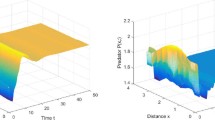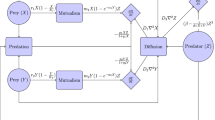Abstract
In this paper, pattern forming instabilities in a three species reaction–diffusion system involving prey–predation, competition and commensalism are explored. The system consists of two competing species, and the third species acts as a predator for one of the species and as a host for the other species. The equilibrium points of the model are determined. The conditions for existence of interior equilibrium point are derived. Bifurcation analysis of the model is done, and conditions for existence of Turing and non-Turing patterns are derived using Routh–Hurwitz criteria. A series of numerical simulation results are presented to show Turing as well as non-Turing patterns. Various types of patterns (e.g., spirals, spots, strips, mixture of spots and strips) are observed depending on the ecological parameters of the local system and diffusion coefficients. The existence of spatially homogeneous, inhomogeneous periodic and inhomogeneous aperiodic oscillations and chaotic oscillations is shown in the three species model.














Similar content being viewed by others
References
Turing, A.M.: On the chemical basis of morphogenesis. Philos. Trans. R. Soc. Lond. B Biol. Sci. 237, 37–72 (1952)
Nicolis, G., Prigogine, I.: Self-Organization in Nonequilibrium Systems. Wiley, New York (1977)
Maini, P., Painter, K., Chau, H.P.: Spatial pattern formation in chemical and biological systems. J. Chem. Soc. Faraday Trans. 93(20), 3601–3610 (1997)
Winfree, A.T.: Spiral waves of chemical activity. Science 175(4022), 634–636 (1972)
Castets, V., Dulos, E., Boissonade, J., Kepper, P.D.: Experimental evidence of a sustained standing Turing-type nonequilibrium chemical pattern. Phys. Rev. Lett. 64(24), 2953 (1990)
Waddington, C.H., Perry, M.M.: The ultrastructure of the developing urodele notochord. Proc. R. Soc. Lond. B Biol. Sci. 156(965), 459–482 (1962)
Gierer, A., Meinhardt, H.: A theory of biological pattern formation. Kybernetik 12(1), 30–39 (1972)
Rogers, K.W., Schier, A.F.: Morphogen gradients: from generation to interpretation. Annu. Rev. Cell Dev. Biol. 27, 377–407 (2011)
Ouyang, Q., Swinney, H.L.: Transition from a uniform state to hexagonal and striped Turing patterns. Nature 352(6336), 610–612 (1991)
Cross, M.C., Hohenberg, P.C.: Pattern formation outside of equilibrium. Rev. Mod. Phys. 65(3), 851–1112 (1993)
Segel, L.A., Jackson, J.L.: Dissipative structure: an explanation and an ecological example. J. Theor. Biol. 37(3), 545–559 (1972)
Medvinsky, A.B., Petrovskii, S.V., Tikhonova, I.A., Malchow, H., Li, B.L.: Spatiotemporal complexity of plankton and fish dynamics. SIAM Rev. 44(3), 311–370 (2002)
Ghorai, S., Poria, S.: Turing patterns induced by cross-diffusion in a predator-prey system in presence of habitat complexity. Chaos Solitons Fractals 91, 421–429 (2016)
Sun, G.Q., Zhang, J., Song, L.P., Jin, Z., Li, B.L.: Pattern formation of a spatial predator-prey system. Appl. Math. Comput. 218(22), 11151–11162 (2012)
Ma, J., Xu, Y., Ren, G., Wang, C.: Prediction for breakup of spiral wave in a regular neuronal network. Nonlinear Dyn. 84(2), 497–509 (2016)
Chen, J.X., Guo, M.M., Ma, J.: Termination of pinned spirals by local stimuli. Europhys. Lett. 113(3), 38004 (2016)
Xu, Y., Jin, W., Ma, J.: Emergence and robustness of target waves in a neuronal network. Int. J. Mod. Phys. B 29(23), 1550164 (2015)
Qin, H., Wu, Y., Wang, C., Ma, J.: Emitting waves from defects in network with autapses. Commun. Nonlinear Sci. Numer. Simul. 23(1), 164–174 (2015)
Liu, T.B., Ma, J., Zhao, Q., Tang, J.: Force exerted on the spiral tip by the heterogeneity in an excitable medium. Europhys. Lett. 104(5), 58005 (2014)
Song, X., Wang, C., Ma, J., Ren, G.: Collapse of ordered spatial pattern in neuronal network. Phys. A Stat. Mech. Appl. 451, 95–112 (2016)
Ma, J., Xu, Y., Wang, C., Jin, W.: Pattern selection and self-organization induced by random boundary initial values in a neuronal network. Phys. A Stat. Mech. Appl. 461, 586–594 (2016)
Lou, Q., Chen, J.X., Zhao, Y.H., Shen, F.R., Fu, Y., Wang, L.L., Liu, Y.: Control of turbulence in heterogeneous excitable media. Phys. Rev. E 85(2), 026213 (2012)
Chen, J.X., Peng, L., Zheng, Q., Zhao, Y.H., Ying, H.P.: Influences of periodic mechanical deformation on pinned spiral waves. Chaos Interdiscip. J. Nonlinear Sci. 24(3), 033103 (2014)
Ghorai, S., Poria, S.: Pattern formation and control of spatiotemporal chaos in a reaction diffusion preypredator system supplying additional food. Chaos Solitons Fractals 85, 57–67 (2016)
Malakar, K., Nandi, J., Mitra, S., Gorai, P.K., Chattopadhyay, S., Banerjee, S.: Rectangular microstrip antenna with air cavity for high gain and improved front to back ratio. J. Electromagn. Anal. Appl. 3(09), 368–372 (2011)
Chakraborty, K., Manthena, V.: Modelling and analysis of spatio-temporal dynamics of a marine ecosystem. Nonlinear Dyn. 81(4), 1895–1906 (2015)
Guin, L.N., Mandal, P.K.: Spatiotemporal dynamics of reaction diffusion models of interacting populations. Appl. Math. Model. 38(17), 4417–4427 (2014)
Song, Y., Zou, X.: Bifurcation analysis of a diffusive ratio-dependent predator–prey model. Nonlinear Dyn. 78(1), 49–70 (2014)
Sun, G.Q., Zhang, G., Jin, Z., Li, L.: Predator cannibalism can give rise to regular spatial pattern in a predator–prey system. Nonlinear Dyn. 58(1–2), 75–84 (2009)
Sun, G.Q.: Pattern formation of an epidemic model with diffusion. Nonlinear Dyn. 69(3), 1097–1104 (2012)
Li, J., Sun, G.Q., Jin, Z.: Pattern formation of an epidemic model with time delay. Phys. A Stat. Mech. Appl. 403, 100–109 (2014)
Li, L., Zhen, J., Gui-Quan, S.: Spatial pattern of an epidemic model with cross-diffusion. Chin. Phys. Lett. 25(9), 3500–3503 (2008)
Sun, G.Q., Jin, Z., Li, L., Li, B.L.: Self-organized wave pattern in a predator-prey model. Nonlinear Dyn. 60(3), 265–275 (2010)
Sun, G.Q., Jusup, M., Jin, Z., Wang, Y., Wang, Z.: Pattern transitions in spatial epidemics: mechanisms and emergent properties. Phys. Life Rev. 19, 43–73 (2016)
Sun, G.Q., Jin, Z., Li, L., Haque, M., Li, B.L.: Spatial patterns of a predator-prey model with cross diffusion. Nonlinear Dyn. 69(4), 1631–1638 (2012)
Sun, G.Q., Wu, Z.Y., Wang, Z., Jin, Z.: Influence of isolation degree of spatial patterns on persistence of populations. Nonlinear Dyn. 83(1–2), 811–819 (2016)
Li, A.W.: Impact of noise on pattern formation in a predator-prey model. Nonlinear Dyn. 66(4), 689–694 (2011)
Sun, G.Q.: Mathematical modeling of population dynamics with Allee effect. Nonlinear Dyn. 85(1), 1–12 (2016)
Sun, G.Q., Wang, S.L., Ren, Q., Jin, Z., Wu, Y.P.: Effects of time delay and space on herbivore dynamics: linking inducible defenses of plants to herbivore outbreak. Sci. Rep. 5, 11246 (2015)
Li, L., Jin, Z., Li, J.: Periodic solutions in a herbivore-plant system with time delay and spatial diffusion. Appl. Math. Model. 40(7), 4765–4777 (2016)
Sun, G.Q., Chakraborty, A., Liu, Q.X., Jin, Z., Anderson, K.E., Li, B.L.: Influence of time delay and nonlinear diffusion on herbivore outbreak. Commun. Nonlinear Sci. Numer. Simul. 19(5), 1507–1518 (2014)
Tang, X., Song, Y., Zhang, T.: Turing-Hopf bifurcation analysis of a predator-prey model with herd behavior and cross-diffusion. Nonlinear Dyn. 86(1), 73–89 (2016)
Hastings, A., Powell, T.: Chaos in a threespecies food chain. Ecology 72(3), 896–903 (1991)
Chattopadhyay, J., Arino, O.: A predator-prey model with disease in the prey. Nonlinear Anal. Theory Methods Appl. 36(6), 747–766 (1999)
May, R.M., Leonard, W.J.: Nonlinear aspects of competition between three species. SIAM J. Appl. Math. 29(2), 243–253 (1975)
Panja, P., Mondal, S.K.: Stability analysis of coexistence of three species preypredator model. Nonlinear Dyn. 81(1–2), 373–382 (2015)
Sahoo, B., Poria, S.: The chaos and control of a food chain model supplying additional food to top-predator. Chaos Solitons Fractals 58, 52–64 (2014)
Freedman, H.I., Waltman, P.: Persistence in models of three interacting predator-prey populations. Math. Biosci. 68(2), 213–231 (1984)
Freedman, H.I., Waltman, P.: Mathematical analysis of some three-species food-chain models. Math. Biosci. 33(3), 257–276 (1977)
Ma, Z.P., Yue, J.L.: Competitive exclusion and coexistence of a delayed reaction-diffusion system modeling two predators competing for one prey. Compu. Math. Appl. 71(9), 1799–1817 (2016)
Morozov, A., Ruan, S., Li, B.L.: Patterns of patchy spread in multi-species reaction–diffusion models. Ecol. Complex. 5(4), 313–328 (2008)
Hata, S., Nakao, H., Mikhailov, A.S.: Sufficient conditions for wave instability in three-component reaction-diffusion systems. Prog. Theor. Exp. Phys. 2014(1), 013A01 (2014)
White, K.A.J., Gilligan, C.A.: Spatial heterogeneity in three species, plant–parasite-hyperparasite, systems. Philos. Trans. R. Soc. B 353(1368), 543–557 (1998)
Zheng, S.: A reaction-diffusion system of a predator-prey-mutualist model. Math. Biosci. 78(2), 217–245 (1986)
Satnoianu, R.A., Menzinger, Maini, P.K.: Turing instabilities in general systems. J. Math. Biol. 41(6), 493–512 (2000)
Chaudhuri, S., Chattopadhyay, J., Venturino, E.: Toxic phytoplankton-induced spatiotemporal patterns. J. Biol. Phys. 38(2), 331–348 (2012)
Parshad, R.D., Kumari, N., Kasimov, A.R., Abderrahmane, H.A.: Turing patterns and long-time behavior in a three-species food-chain model. Math. Biosci. 254, 83–102 (2014)
Tian, C., Ling, Z., Lin, Z.: Turing pattern formation in a predator-prey-mutualist system. Nonlinear Anal. Real World Appl. 12(6), 3224–3237 (2011)
Lv, Y., Yuan, R., Pei, Y.: Turing pattern formation in a three species model with generalist predator and cross-diffusion. Nonlinear Anal. Theory Methods Appl. 85, 214–232 (2013)
Kuwamura, M.: Turing instabilities in prey-predator systems with dormancy of predators. J. Math. Biol. 71(1), 125–149 (2015)
Polis, G.A., Myers, C.A., Holt, R.D.: The ecology and evolution of intraguild predation: potential competitors that eat each other. Annu. Rev. Ecol. Syst. 20, 297–330 (1989)
Gakkhar, S., Gupta, K.: A three species dynamical system involving prey–predation, competition and commensalism. Appl. Math. Comput. 237, 54–67 (2016)
Nagumo, M.: Über die lage der integralkurven gewöhnlicher differentialgleichungen. Nippon Sugaku-Buturigakkwai Kizi Dai 3 Ki 24(0), 551–559 (1942)
Rosenzweig, M.L., MacArthur, R.H.: Graphical representation and stability conditions of predator-prey interaction. Am. Nat. 97, 209–223 (1963)
Hawick, K.A., James, H.A., Scogings, C.J.: A zoology of emergent patterns in a predator-prey simulation model. In: Proceedings of the Sixth IASTED International Conference on Modelling, Simulation, and Optimization, Gabarone, Botswana, pp. 84–89 (2006)
Author information
Authors and Affiliations
Corresponding author
Rights and permissions
About this article
Cite this article
Ghorai, S., Poria, S. Pattern formation in a system involving prey–predation, competition and commensalism. Nonlinear Dyn 89, 1309–1326 (2017). https://doi.org/10.1007/s11071-017-3517-y
Received:
Accepted:
Published:
Issue Date:
DOI: https://doi.org/10.1007/s11071-017-3517-y




